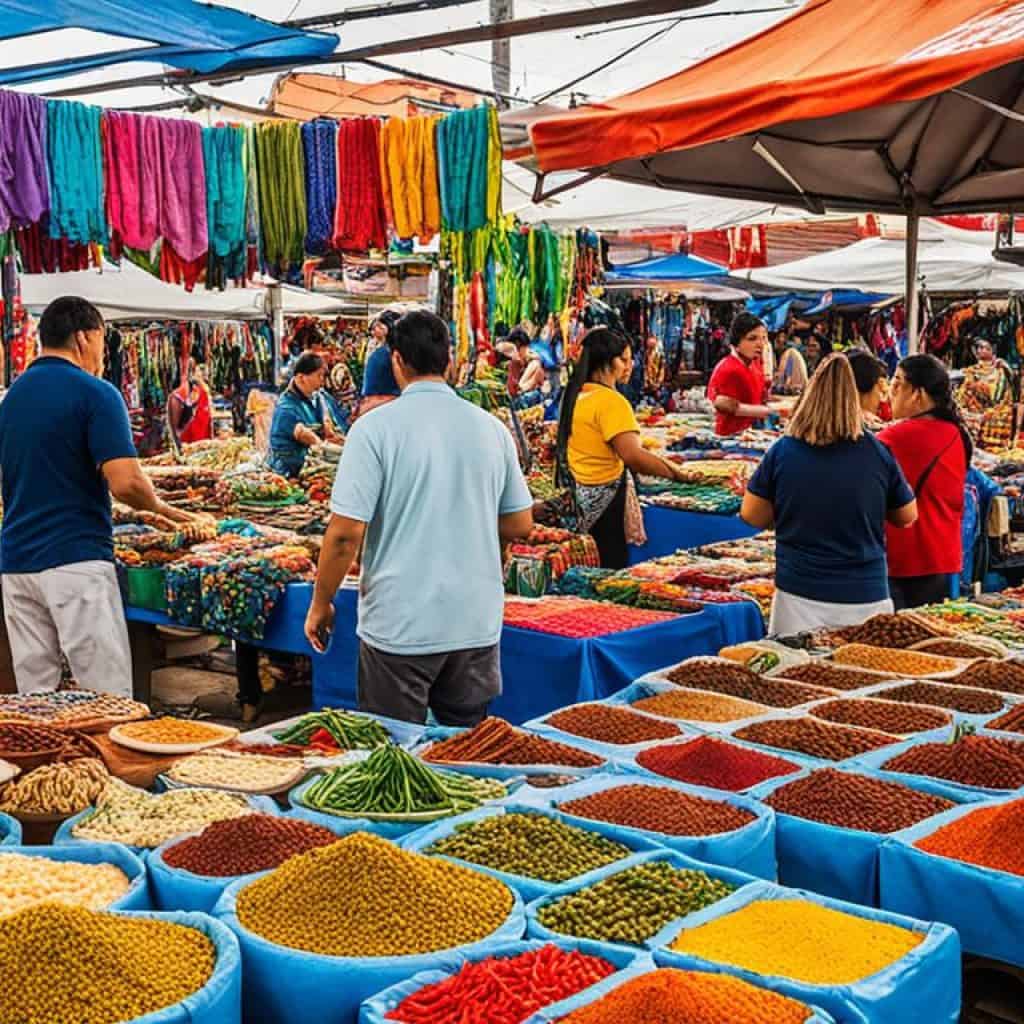Do you dream of exploring the beautiful islands of the Philippines? Imagine yourself in the heart of vibrant Filipino culture. You’re connecting with locals, creating memories that will last forever. But, you’re worried about not being able to communicate.
Learning Filipino, especially Tagalog, is your key to unlocking these experiences. Knowing some essential Tagalog phrases helps you move around the Philippines easily. It also deepens your cultural understanding and builds strong connections with the locals.
This article will show you the most important Tagalog phrases. You’ll learn how to greet people, thank them, ask for directions, and even order food and drinks. Get ready to overcome language barriers and engage in meaningful interactions.
So, are you ready to dive deep into Filipino culture and truly experience the Philippines? Begin your journey in learning Tagalog today and discover the rich essence of this amazing country!
Key Takeaways:
- Learning Tagalog can enhance your travel experience in the Philippines.
- Mastering essential Tagalog phrases will help you navigate Filipino culture and connect with locals.
- From greetings to expressions of gratitude, understanding Tagalog opens doors to a more immersive experience.
- Don’t let the language barrier hold you back – start your Tagalog language journey today!
- Stay tuned for our comprehensive guide to learn essential Filipino Tagalog phrases!
Why Learn Tagalog?
Tagalog is the national language of the Philippines and is spoken by most Filipinos. While English is also widespread, understanding Tagalog allows for deeper cultural connections. It makes navigating signs, menus, and transport much easier. Whether for travel or business, speaking Tagalog enriches your experience in the Philippines.
As the country’s main dialect, Tagalog is key for meaningful conversations and cultural immersion. Whether you’re in bustling Manila, on Boracay’s pristine beaches, or at Cebu’s lively festivals, Tagalog helps you communicate authentically. It connects you with locals for a richer cultural journey.
Learning Tagalog also opens a window to the Filipino way of life, customs, and traditions. Languages let us grasp a culture’s subtleties, including its folklore and values. Speaking Tagalog uncovers hidden gems, from old sayings to local tales, enriching your cultural exploration.
The Importance of Tagalog Translation
Mastering Tagalog can boost your career in translation and cross-cultural communication. If you’re in tourism, hospitality, or international business, Tagalog skills set you apart. They help overcome language barriers and strengthen ties with Filipino colleagues, clients, or partners.
Moreover, Tagalog translators are in demand globally. As the Philippines grows in outsourcing and customer service, Tagalog knowledge is a major plus. It aids companies wanting to expand in the Philippines, ensuring translations are accurate and culturally correct.
| Benefits of Learning Tagalog | Examples |
|---|---|
| Deeper cultural understanding | Dive deep into local culture by understanding Filipino nuances and traditions. |
| Enhanced travel experience | Easily navigate signs, menus, and transport, making Philippine travels smoother and more fun. |
| Meaningful interactions | Form deeper connections with locals, leading to genuine interactions and unforgettable moments. |
| Business opportunities | Grow your career by offering translation services and building strong ties in Tagalog-requiring industries. |
Learning Tagalog goes beyond just a new language; it’s about embracing a culture and seeing the world differently. Why hesitate? Begin your Tagalog journey today and discover the Philippines’ vibrant culture.
Basic Phrases for Everyday Conversations
When starting with Tagalog, learning some basic phrases is important. These will help you in daily talks:
Kamusta ka? – How are you?
Salamat – Thank you
Oo – Yes
Hindi – No
Pakiulit – Please repeat
Puwede ba – Can I
Paalam – Goodbye
| English | Tagalog |
|---|---|
| Hello | Kamusta |
| Excuse me | Sensya na |
| I’m sorry | Patawad |
| How much? | Magkano? |
| Where is the restroom? | Saan ang banyo? |
Knowing these basic phrases is helpful in many situations. You could be asking for directions, ordering food, or just saying hello. With practice, you’ll find yourself comfortable in daily Tagalog conversations.
Greetings and Introductions
Filipino culture values respect and hospitality highly. When talking to Filipinos, it’s important to use the right greetings. Here are some useful Tagalog phrases to start off on the right foot:
Kumusta po kayo? – How are you? (formal)
Kamusta ka? – How are you? (informal)
Ako si [name]. – I am [name].
Magandang umaga! – Good morning!
Magandang tanghali! – Good noon!
Magandang hapon! – Good afternoon!
Magandang gabi! – Good evening!
When you meet someone for the first time, saying “Mano po” is a respectful practice. This involves taking an elder’s hand and pressing it to your forehead.
Knowing these greetings and introductions shows you respect Filipino culture. It helps you bond with people.
Additional Tips
Making eye contact shows respect in Filipino culture. Always smile and listen carefully when you’re talking to someone.
Using “po” and “opo” when talking to elders or superiors is polite. It shows respect.
Lastly, trying to speak Tagalog is highly valued, even if you make mistakes. People will see your effort and appreciate it.
Expressing Gratitude
Expressing gratitude is key in Filipino culture. Filipinos are known for their warmth and kindness. To show appreciation, here are essential Tagalog phrases:
1. “Salamat po” – Thank you
“Salamat po” is the polite way to say “thank you” in Tagalog. Adding “po” shows respect. You can use this in many situations, like thanking anyone.
2. “Maraming salamat” – Thank you very much
For extra thanks, say “Maraming salamat”. It means “thank you very much.” This shows deep appreciation for help or kindness.
3. “Maganda ang loob ko sa iyo” – I appreciate you
To express heartfelt thanks, use “Maganda ang loob ko sa iyo”. It means “I appreciate you.” This phrase highlights your value for someone’s character.
But remember, gratitude isn’t just words. Show it with true feelings, a warm smile, and respect. This way, you’ll connect deeply with Filipinos and experience their rich culture.

Asking for Directions
Exploring new places, you might need directions. Knowing a few Tagalog phrases helps a lot. Here are phrases to guide you:
Saan ang [place]?
Ano pong daan papuntang [place]?
Pwede pakisabi kung saan ang [place]?
When searching for a place, ask “Saan ang [place]?”. It means “Where is [place]?” For example, to find a train station, simply say “Saan ang istasyon ng tren?”
“Ano pong daan papuntang [place]?” is another useful phrase. It means “Which way to [place]?” Use it when walking or driving to find your destination.
For a polite question, say “Pwede pakisabi kung saan ang [place]?”. It translates to “Can you kindly tell me where [place] is?” This shows respect.
Use a friendly tone with greetings. Say “Magandang araw po!” or “Kumusta po kayo?” for good interactions.
In Manila or Palawan, these Tagalog phrases ease navigation. Practice them to ask for directions confidently and enjoy the Philippines.
Ordering Food and Drinks
Visiting the Philippines? Don’t miss out on the food. Filipino cuisine is a mix of tastes from different areas. To dive into the dining scene, learn some Tagalog phrases for ordering.
Greetings and Politeness
Start by greeting staff with “Magandang araw po” (Good day) or “Kumusta po?” (How are you?). These greetings show respect and set a friendly tone.
Browse the Menu
Looking at the menu? If you need help, just ask, “Pwede po ba akong humingi ng tulong sa pagpili?” This means you’d like some advice on what to choose.
Placing Your Order
Ready to order? Say “I-order ko po ito” and the dish’s name. For adobo, say “I-order ko po ang adobo.” Or, “Gusto ko po ng halo-halo” for a halo-halo.
Special Requests
Have dietary needs? Tell the staff. Ask “Mayroon po ba kayong mga pagkain para sa mga taong may allergies?” for allergy-friendly options. Or, “Pwede po ba akong mag-request ng isang vegetarian dish?” for vegetarian dishes. Sharing your needs helps ensure a great meal.
Enjoy Your Meal
When your meal arrives, share “Kain tayo” (Let’s eat) with your group. It’s a sign of the Filipino spirit of sharing and hospitality during meals.
| English | Tagalog | Pronunciation |
|---|---|---|
| Water | Tubig | too-beg |
| Rice | Kanin | ka-neen |
| Chicken | Manok | ma-nok |
| Pork | Baboy | ba-boy |
| Beef | Karne | kar-ne |
| Vegetables | Gulay | goo-lay |
| Fish | Isda | ees-da |
| Soup | Sabaw | sa-baw |
| Beer | Beer | beer |
| Coffee | Kape | ka-peh |
| Tea | Tsaa | tsa-ah |
Knowing these phrases and words for common dishes will help you enjoy Filipino food more. Remember, each meal is not just about taste but also the joy of sharing.
Transportation Phrases
Traveling in the Philippines is an adventure. In Manila’s busy streets or between stunning islands, knowing key Tagalog phrases helps. These phrases make local travel easier:
Taxi:
Use these phrases in taxis:
“Manong, sa [destination] po, salamat.” (Driver, to [destination] please, thank you.)
“Magkano po?” (How much?)
Jeepney:
Jeepneys are a common transport option. For jeepney rides, try these phrases:
“Bayad po.” (Payment, please.)
“Para po dito sa [destination].” (Please stop here at [destination].)
Tricycle:
In smaller towns, tricycles are everywhere. Speak to drivers like this:
“Manong, sa [destination] po, magkano?” (Driver, how much to [destination]?)
“Paki-pababa na lang po dito, salamat.” (Please drop me off here, thank you.)
Public Bus:
For bus travel across regions, use these phrases:
“Manong/Manang, saan po dito ang sakayan papuntang [destination]?” (Sir/Ma’am, where is the bus stop for [destination]?)
“Magkano po ang pamasahe papuntang [destination]?” (How much is the fare to [destination]?)
Train:
The MRT and LRT make city travel easy. Use these train phrases:
“Saan po ang bilihan ng ticket?” (Where is the ticket booth?)
“Anong pinto po ba ang bababaan papuntang [destination]?” (Which door for [destination]?)
Always be respectful and patient with transport workers. With these phrases, you’re set for a confident Philippine adventure. Ride a jeepney, tricycle, or colorful bus and enjoy!
Shopping and Bargaining
Shopping in the Philippines is full of life. You blend with the local culture. From lively markets to modern malls, knowing some Tagalog phrases helps get the best deals. Let’s learn some:
1. Magkano ito? – How much is this?
2. Pwede bang tawad? – Can I bargain?
3. Mahal masyado, pwede bang mas mura? – It’s too expensive, can you give me a lower price?
4. Anong pinakamababang presyo? – What’s the lowest price?
5. Bibili ako ng isa pang item, may discount ba? – I’m going to buy another item, can I get a discount?
6. Mas mura sa iba, pwede bang pababain ang presyo? – It’s cheaper somewhere else, can you lower the price?
Bargaining is common in the Philippines. Don’t hesitate to ask for a better price. Always be polite and respectful while negotiating.
For souvenirs or handicrafts, knowing some Tagalog names helps. Here are common words:
- Bags – mga bag
- T-shirts – mga t-shirt
- Handmade accessories – mga gawaing kamay na akseso
- Wood carvings – mga kahoy na inukit
- Local delicacies – mga lokal na kakanin
Using these phrases helps you shop with confidence. Engage in friendly bargaining. Enjoy the vibrant atmosphere and bring home unique treasures from the Philippines.
Common Expressions and Slang
Learning basic phrases is great. But knowing common expressions and slang in Tagalog brings you closer to Filipinos. Whether you aim to start conversations or get the local jokes, these phrases will turn you into a Tagalog expert:
“Ano ba yan!” – Use this to show you’re surprised or can’t believe something. It’s like saying “Oh my!” in English.
“Sige na!” – This nudges someone to proceed or agree. It means “Go ahead!” or “Come on!”
“Ganito lang ‘yan.” – It translates to “It’s just like this”. Use it to express a relaxed attitude when plans fail or to make light of a situation.
“Chika lang!” – Means “just chatting”. It’s for when you’re catching up or spreading gossip.
“Yosi break” – This refers to a cigarette break. It’s a common call among colleagues or friends who want to pause for a smoke.
Using these expressions will not only help you bond with Filipinos but also show your love for the Tagalog language. So, try adding these phrases to your talks and enjoy the local vibe!
Polite Expressions
Being polite is very important in Filipino culture. When you meet locals, shopkeepers, or service staff, being polite is key. It helps you show respect and make friends. Here are some key phrases for different situations:
Greetings
- Kamusta po kayo? (How are you?)
- Magandang umaga/pagkakataon. (Good morning/afternoon.)
- Mabuhay! (Welcome!)
Apologies
- Pasensya na po. (Sorry.)
- Patawad po. (I apologize.)
- Paumanhin po. (Excuse me.)
Asking Permission
- Puwede po bang… (Can I…)
- Maaaring hilingin po ba… (May I request…)
- Pakiusap po. (Please.)
Thanking
- Maraming salamat po. (Thank you very much.)
- Salamat po sa inyo. (Thank you to you.)
- Saludo po ako sa inyo. (I salute you.)
Using these polite phrases shows you care about Filipino culture. It also makes a good impression on locals. Remember, Filipinos are very friendly. So, being polite helps you connect with them better.
Expressing Emotions
Learning to express emotions is key when connecting with Filipinos deeply. Tagalog has phrases to convey feelings accurately. Knowing these tagalog phrases helps you share your emotions better. Here are some common phrases for expressing feelings in Tagalog:
Joy/Happiness
- Masaya ako – I am happy
- Nakakatuwa – It’s amusing
- Sobrang saya ko – I’m extremely happy
Sadness
- Malungkot ako – I am sad
- Sobrang lungkot – Extremely sad
- Gusto ko lang umiyak – I just want to cry
Excitement
- Nakakakilig – It’s thrilling
- Ang saya-saya – It’s so exciting
- Grabe, ang sarap ng feeling – Wow, the feeling is amazing
Learning these tagalog translations to express emotions will improve your communication and deepen connections with Filipinos.
Use these phrases to express yourself to locals and form deep connections in the Philippines!
Cultural Etiquette
When you visit the Philippines, it’s crucial to understand their cultural etiquette. This ensures respectful and engaging moments with the locals. Here are some essential tips:
Respect for Elders
In the Philippines, people highly value respect for elders. It’s usual to use “po” and “opo” when talking to seniors. This shows respect. When you meet them, greet the eldest first. Wait for them to offer a handshake or a hug.
Family-oriented Culture
Families are a big deal in Filipino life. Often, many generations live under one roof and cherish family gatherings. Bringing a small gift, like food or flowers, is polite when visiting someone’s home. It’s a sign of appreciation.
Showing Humility
Being humble is important in Filipino culture. Steer clear of acting boastful or arrogant. It’s not welcomed. Always express gratitude, stay modest, and be eager to hear and learn from others.
“In Filipino culture, showing respect and humility is the cornerstone of meaningful connections.”
– Filipino Proverb
Proper Dining Etiquette
When eating with Filipinos, always let the eldest start the meal first. Leaving food on your plate is frowned upon. It might look like you didn’t enjoy the food. Always thank your host for their hospitality.
Modest Dress Code
It’s key to dress modestly at religious sites or formal events. Skip the revealing outfits or shorts in these places. Wearing traditional Filipino clothes like a barong or a Filipiniana dress gets you extra points.
Non-verbal Communication
Body language and facial expressions mean a lot to Filipinos. Keep eye contact during talks. Nodding and smiling politely show you’re attentive and agreeable.
| DO | DON’T |
|---|---|
| Use “po” and “opo” when addressing elders. | Interrupt or speak over others. |
| Show gratitude and appreciation. | Display arrogance or boastful behavior. |
| Wait for the eldest person to begin eating before starting your meal. | Leave food on your plate. |
| Dress modestly and conservatively. | Wear revealing clothing or shorts in formal or religious settings. |
| Maintain good eye contact and use polite gestures. | Show disinterest or indifference. |
Following these guidelines on cultural etiquette shows your respect for Filipino traditions. Embrace humility, gratitude, and respect. You’re sure to have an enriching experience in the Philippines.

Language Learning Resources
If you want to get better at speaking Tagalog, there are many tools you can use. Here’s a list of great ways to improve your Tagalog skills:
- Online Language Courses: These online platforms offer detailed Tagalog courses. You’ll find structured lessons, fun exercises, and audio clips. Learn at your own speed, mastering Tagalog phrases and words.
- Language Learning Apps: Try apps like Duolingo, Babbel, or Rosetta Stone for Tagalog lessons. They make learning fun with exercises, quizzes, and games. You’ll get to practice speaking, listening, and reading in Tagalog.
- Tagalog Phrasebooks: Get a Tagalog phrasebook for useful phrases and expressions. They’re small, so you can take them anywhere. They’re perfect for quick references in different situations.
- Language Exchange Programs: Join language exchange communities online. Connect with native Tagalog speakers who want to learn your language. It’s a great way to practice talking in Tagalog and make new friends.
- Tagalog Language Websites: Check out websites with free Tagalog learning materials. You’ll find lessons, explanations on grammar, vocabulary lists, and audio to improve your Tagalog.
Remember, practicing regularly and immersing yourself in Tagalog is essential. With these resources, you’ll become good at Tagalog in no time.
Conclusion
Learning Tagalog opens up many doors in the Philippines. It lets you easily blend into Filipino culture. This skill helps you make strong connections with locals.
Whether your visit is for fun or work, knowing Tagalog makes it better. You will leave a lasting mark on those you encounter. Start your Tagalog journey today to see Filipino culture’s true beauty.
With Tagalog, you can have deep talks, find hidden spots, and dive into the Philippines’ lively traditions. Let the Filipino language show you all the amazing things this country has. Get ready for your adventures!







Add comment